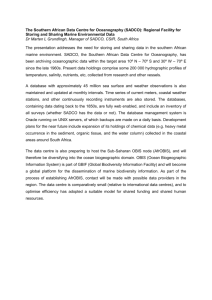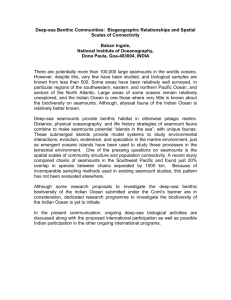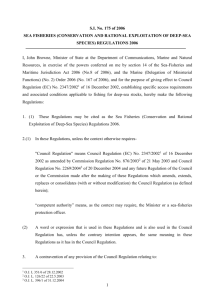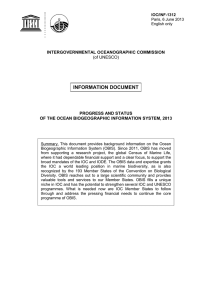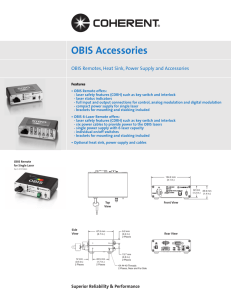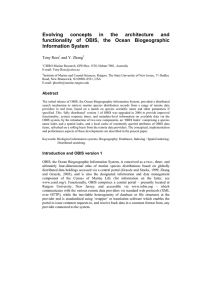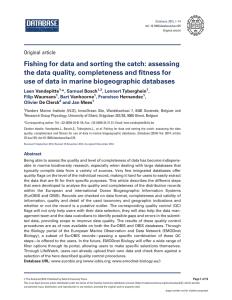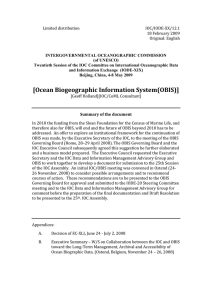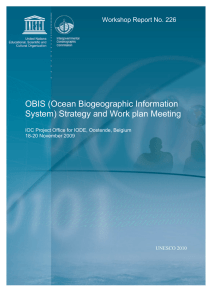It’s Your Opinion Biodiversity baselines in the deep sea Appeltans Ward
advertisement
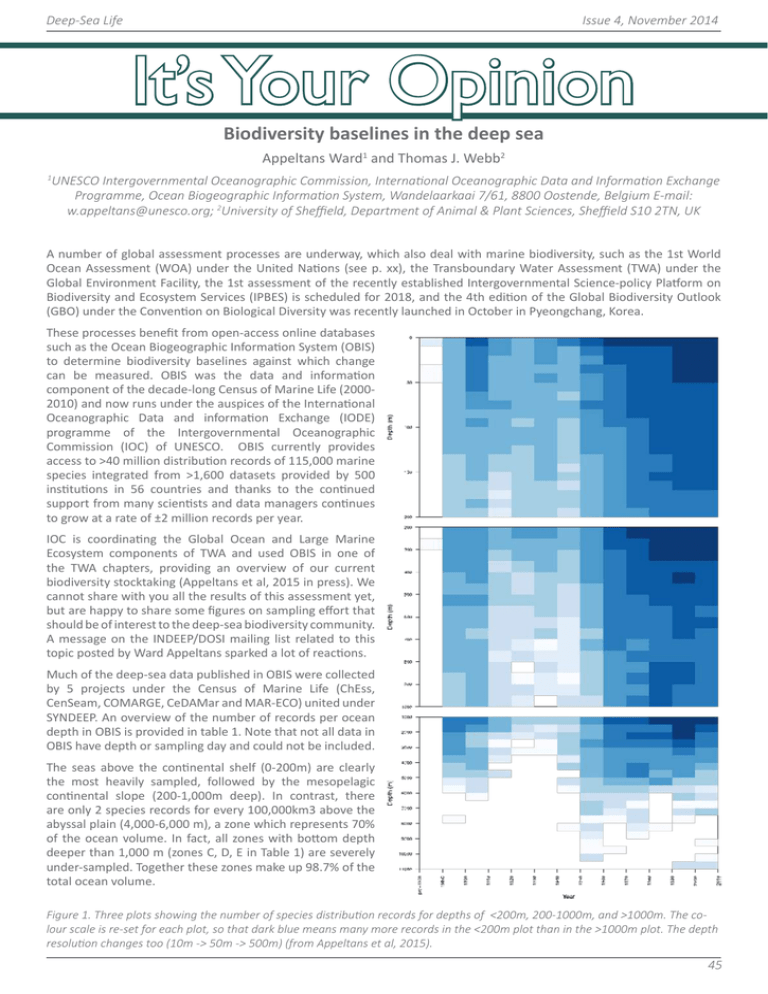
Deep-Sea Life Issue 4, November 2014 It’s Your Opinion Biodiversity baselines in the deep sea Appeltans Ward1 and Thomas J. Webb2 UNESCO Intergovernmental Oceanographic Commission, International Oceanographic Data and Information Exchange Programme, Ocean Biogeographic Information System, Wandelaarkaai 7/61, 8800 Oostende, Belgium E-mail: w.appeltans@unesco.org; 2University of Sheffield, Department of Animal & Plant Sciences, Sheffield S10 2TN, UK 1 A number of global assessment processes are underway, which also deal with marine biodiversity, such as the 1st World Ocean Assessment (WOA) under the United Nations (see p. xx), the Transboundary Water Assessment (TWA) under the Global Environment Facility, the 1st assessment of the recently established Intergovernmental Science-policy Platform on Biodiversity and Ecosystem Services (IPBES) is scheduled for 2018, and the 4th edition of the Global Biodiversity Outlook (GBO) under the Convention on Biological Diversity was recently launched in October in Pyeongchang, Korea. These processes benefit from open-access online databases such as the Ocean Biogeographic Information System (OBIS) to determine biodiversity baselines against which change can be measured. OBIS was the data and information component of the decade-long Census of Marine Life (20002010) and now runs under the auspices of the International Oceanographic Data and information Exchange (IODE) programme of the Intergovernmental Oceanographic Commission (IOC) of UNESCO. OBIS currently provides access to >40 million distribution records of 115,000 marine species integrated from >1,600 datasets provided by 500 institutions in 56 countries and thanks to the continued support from many scientists and data managers continues to grow at a rate of ±2 million records per year. IOC is coordinating the Global Ocean and Large Marine Ecosystem components of TWA and used OBIS in one of the TWA chapters, providing an overview of our current biodiversity stocktaking (Appeltans et al, 2015 in press). We cannot share with you all the results of this assessment yet, but are happy to share some figures on sampling effort that should be of interest to the deep-sea biodiversity community. A message on the INDEEP/DOSI mailing list related to this topic posted by Ward Appeltans sparked a lot of reactions. Much of the deep-sea data published in OBIS were collected by 5 projects under the Census of Marine Life (ChEss, CenSeam, COMARGE, CeDAMar and MAR-ECO) united under SYNDEEP. An overview of the number of records per ocean depth in OBIS is provided in table 1. Note that not all data in OBIS have depth or sampling day and could not be included. The seas above the continental shelf (0-200m) are clearly the most heavily sampled, followed by the mesopelagic continental slope (200-1,000m deep). In contrast, there are only 2 species records for every 100,000km3 above the abyssal plain (4,000-6,000 m), a zone which represents 70% of the ocean volume. In fact, all zones with bottom depth deeper than 1,000 m (zones C, D, E in Table 1) are severely under-sampled. Together these zones make up 98.7% of the total ocean volume. Figure 1. Three plots showing the number of species distribution records for depths of <200m, 200-1000m, and >1000m. The colour scale is re-set for each plot, so that dark blue means many more records in the <200m plot than in the >1000m plot. The depth resolution changes too (10m -> 50m -> 500m) (from Appeltans et al, 2015). 45 Deep-Sea Life Issue 4, November 2014 Figure 1 shows how species distribution records have accumulated through time by depth. Although the deep sea remains poorly sampled, sampling the shelf (i.e. 500-1,500m) has increased through time, with 70x more records in the 1990s (c.170,000) than in the 1950s (c. 2,500). Sampling between 3,000-5,000m peaked in the 1970s (c. 7,500 records), dropping to c. 1,600 records in the 2000s, and sampling between 1,000-3,000m peaked in the 1990s (c. 78,000 records), down to c. 37,000 records in 2000s. Zone A: Continental shelf (0-200m) B: Mesopelagic continental slope (200-1,000m) C: Bathypelagic continental slope (1,000-4,000m) D: Abyssal plain (4,000-6,000m) E: Hadal zone (>6,000m) Sampling days 529,248 (13,471) Species 89,418 (2,276) % Ocean Volume 0.31 266,846 (1,961) Records 10,154,841 (258,467) 2,086,305 (15,330) 42,200 (310) 1.07 339,696 (100) 2,428,958 (713) 43,743 (13) 26.77 103,038 (12) 1,790 (10) 778,213 (87) 21,039 (106) 17,650 (2) 1,749 (9) 70.32 1.56 Table 1: Number of sampling days, species distribution records and species within each depth zone of the global ocean. Actual counts are followed in parentheses by numbers normalized per 105 km3. The contribution of each zone to the volume of the global ocean is also shown (data from OBIS, June 2014 in Appeltans et al, 2015). The peaks in the 1970s likely correspond with the origins of quantitative deep-sea ecology (Sanders & Hessler 1969) and the discovery of hydrothermal vent communities (Spiess et al. 1980). However, we are not certain about the reasons for the recent drop-offs in the areas below 1,000m. An obvious reason could be due to the time lag between sampling events and transfer of data to OBIS, but why would this be different from more shallow areas? The drop-off may as well reflect a shift in sampling efforts or methods (e.g. more image data which are not automatically translated into point observation data useful for sharing via OBIS). Surprisingly is also that while there are a lot less species per volume in the deep-sea compared to the continental shelf, the number of species per sampling day is more or less the same for all zones A to D (between 0.13 and 0.16), except for the Hadal zone where 9 species are observed on average per sampling day. This may be due to more targeted sampling methods or different sampling volumes in the deep-sea for which these numbers are not corrected. In conclusion, an analysis on the current status of our knowledge of deep-sea biodiversity would benefit from a global inventory of all deep-sea expeditions and data holdings, which could be coordinated under INDEEP or DOSI. Furthermore, efforts are underway to have a closer cooperation between IOC (OBIS) and the International Seabed Authority to create a global deep-sea biodiversity data-sharing platform. Publishing these data via open-access repositories like OBIS would benefit all scientists and resource managers as well as science as a whole. The TWA biodiversity chapter also provides many more basic indicators of global biodiversity, so watch this space: http:// onesharedocean.org. For more information on OBIS and how you can publish your data via OBIS contact Ward Appeltans at info@iobis.org or w.appeltans@unesco.org. References - Appeltans W., Dujardin F., Flavell M., Miloslavich P., Webb T. (2015). Biodiversity Baselines in the Global Ocean. In: Fischer A. et al (Eds). Open Ocean Technical Assessment Report for the GEF Transboundary Water Assessment Programme (TWAP). UNEP, IOC-UNESCO. In press.- Sanders, H.L. and Hessler, R.R. (1969). Ecology of the Deep-Sea Benthos. Science, 163(3874), 1419-1424. DOI:-1424f the Deep-Sea Benthos. - Spiess, F.N., Macdonald, K.C., Atwater, T., Ballard, R., Carranza, A., et al. (1980) East Pacific Rise: hot springs and geophysical experiments. Science 207(4438) 1421–1433. COML Deep-Sea projects Census of Diversity of Abyssal Marine Life (CeDAMar) Continental Margin Ecosystems (COMARGE) Mid-Atlantic Ridge Ecosystems (MarEco) Global Census of Marine Life on Seamounts (CenSeam) Biogeography of Deep-Water Chemosynthetic Ecosystems (ChEss) Towards a first global synthesis of biodiversity, biogeography and ecosystem function in the deep sea (SYNDEEP) 46
